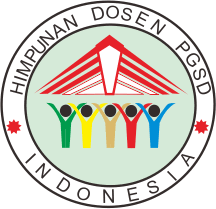Peningkatan keterampilan menyajikan data dalam bentuk diagram melalui model Problem Based Learning kelas IV sekolah dasar
Abstract
The purpose of the reseach is to improve the skills of presenting data in the form of diagrams through the use of the Problem Based Learning model in fourth grade students of SD N Laweyan No. 54 Surakarta 2018/2019 school year. Classroom Action Research is conducted in two cycles, each cycle consisting of two meetings with four stages, namely planning, action, observation, and reflection. The subjects of this study were teachers and fourth grade students, amounting to 34 students. This study uses observational techniques, interviews, documentation, and tests. Data analysis using interactive data analysis with steps of data reduction, data presentation, and conclusions. The data validity test technique uses source triangulation and technical triangulation The results showed that the average score of pre-action class scores of 17.97 with 0% classical completeness increased to 75.88 with 61.76% classical completeness in the first cycle and increased again to 87.25 with a classical completeness of 88.24% in cycle II. Based on the results of the study, it can be concluded that through the application of the Problem Based Learning model can improve the skills of presenting data in the form of diagrams in class IV SD N Laweyan No. 54 Surakarta 2018/2019 school year.
Full Text:
PDFReferences
Shadiq, Fadjar. (2014). Pembelajaran Matematika : Cara Meningkatkan Kemampuan Berpikir Peserta didik. Yogyakarta : Graha Ilmu. Halaman 3. [2] Kusaeri. (2014). Acuan dan Teknik Penilaian Proses dan Hasil Belajar dalam Kurikulum 2013. Yogyakarta : Ar-Ruzz Media. Halaman 40. [3] Kunandar. (2013). Penilaian Autentik : Penilaian Hasil Belajar Peserta Didik Berdasarkan Kurikulum 2013. Jakarta : Rajawali Pers. Halaman 249. [4] Abdullah, Ahmad Anis. Suhartini. (2017). Meningkatkan Kemampuan Berpikir Kritis Melalui Pembelajaran Statistika Berbasis Pendidikan Politik di Lingkungan Sekolah. Jurnal Gantang. 2 (1), p2. Diperoleh 25 Maret 2019, dari http://ojs.umrah.ac.id/index.php/gantang/index [5] Syah, Muhibbin. (2013). Psikologi Pendidikan. Cet. XVIII. Bandung : Remaja Rosdakarya. Halaman 117. [6] Ngalimun. (2012). Strategi dan Model Pembelajaran. Cet. I. Yogyakarta : Aswaja Pressindo. Halaman 90. [7] Putera, Sitiatava R. (2013). Desain Belajar Mengajar Kreatif Berbasis Sains. Yogyakarta : Diva Press. Halaman 78. [8] Sani, Berlin. & Kurniasih, Imas. (2015). Ragam Pengembangan Model Pembelajaran. Jakarta : Kata Pena. Halaman 49. [9] Amirono. & Daryanto. (2016). Evaluasi dan Penilaian Pembelajaran Kurikulum 2013. Yogyakarta : Gava Media. Halaman 38. [10] Ulger, Kani. (2018). The Effect of Problem-Based Learning on the Creative Thinking and Critical Thinking Disposition of Students in Visual Arts Education. Interdisciplinary Journal of Problem-Based Learning, 12 (1), p3. Diperoleh 12 September 2018 dari https://docs.lib.purdue.edu/ijpbl/vol12/iss1/10/ [11] Sugiyono. (2009). Metode Penelitian Pendidikan (Pendekatan Kualitatif, Kuantitatif, dan R&D). Cet. VII. Bandung : Alfabeta. Halaman 373. [12] Diah Restiningsih. (2016). “Peningkatan Keterampilan Menyimak melalui Penerapan Model Problem Based Learning (PBL)”. Skripsi Tidak Dipublikasikan. Universitas Sebelas Maret, [13] Supartinah, Christina. (2010). Penerapan Metode Problem Base Learning untuk Meningkatkan Kemampuan Pemecahan Masalah Matematika Kelas V SD Negeri Bedoro 3 Kec. Sambungmacan Tahun Pelajaran 2009/2010. Skripsi Tidak Dipublikasikan. Universitas Sebelas Maret. [14] Nafiah, Yunin Turun. 2014. Penerapan Model Problem-Based Learning untuk Meningkatkan Keterampilan Berpikir Kritis dan Hasil Belajar Siswa .Jurnal Pendidikan Vokasi. 4 (1), p130. Diperoleh 24 Maret 2019, dari https://journal.uny.ac.id [15] Gunantara, dkk. 2014. Penerapan Model Pembelajaran Problem Based Learning untuk Meningkatkan Kemampuan Pemecahan Masalah Matematika Siswa Kelas V. Jurnal Mimbar Universitas Pendidikan Ganesha. 2 (1). Diperoleh 24 Maret 2019, dari https://ejournal.undiksha.ac.id
Refbacks
- There are currently no refbacks.



